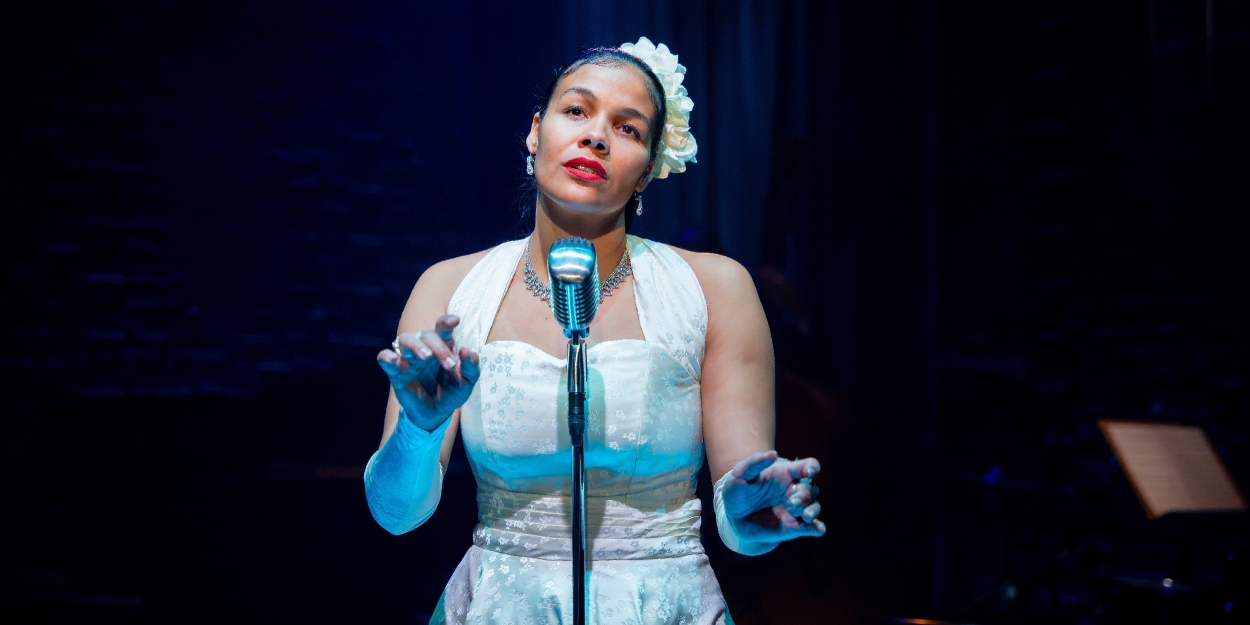Review: LADY DAY AT EMERSON'S BAR AND GRILL, at Space Theatre, Adelaide Festival Centre
A sensational evening at the theatre.

Reviewed by Barry Lenny, Tuesday 29th August 2023.
I have been playing and listening to jazz for over half a century and my collection of recordings, naturally, contains many by Billie Holliday. Consequently, I looked forward to seeing the State Theatre Company’s production of Lanie Robertson’s 1986 play, Lady Day at Emerson’s Bar and Grill, directed by the company’s Artistic Director, Mitchell Butel, with Associate Director, Zahra Newman, as Billie Holliday. This is a co-production by State Theatre Company South Australia, Belvoir Street Theatre, and Melbourne Theatre Company.
Mitchell Butel and Zahra Newman have created a miniature masterpiece, and her performance is a master class.
Billie was born Elinore (she changed the spelling to Eleanora) Harris, on 7th April 1915 to Sarah Julia ‘Sadie’ Harris and Clarence Halliday, two unwed teenagers. Her mother was thirteen, and her father was not a lot older. She and her mother used the surname Fagan, that of Sadie’s mother’s father, and she added Gough, for her mother’s second husband. She later began using the stage name Billie, after Billie Dove, a film actress, and Holiday, a variation of her father’s name. It was the great tenor saxophonist, Lester Young, who gave her the nickname, Lady Day. In return, she called him The President, shortened to Prez. Ellington was already the Duke, Basie the Count, and Joe Oliver, followed by Nat Cole, was the King. He also named her mother The Duchess.
As it begins, we are in a dive bar in Philadelphia, a town she hated because it was where she was arrested and sent to Alderson Federal Prison Camp for a year and a day for possession of drugs belonging to her lover, trombonist, Jimmy Monroe. It is 1959, and Billie Holiday is about to begin one of her last performances. Introduced by her accompanist, Jimmy Powers, she is clearly intoxicated, and continues to drink throughout the performance. She died, four months later, from cirrhosis, on 17th July 1959, aged only forty-four. Her life is well documented, so it is giving nothing away to say that drugs had a great deal to do with her traumatic existence.
Zahra Newman is not just a Billie Holiday impersonator, although she does capture much of the voice, style, phrasing, and emotional intensity of Holiday’s performances. This play is about the person, her life, and the performances that were such a big part of it for a, sadly, very short time. It demands a high order of acting to create such a complex character but, more than that, there is the added level of playing a convincing drunk. So often, actors playing drunks overdo it, and become caricatures, but not so with Newman.
Billie sings, then digresses into rambling memories, starting, stopping, and changing direction, while her accompanist, Jimmy Powers, tries to catch her attention and bring her back to her singing. The drifting worsens as she drinks, and slips back to her dressing room briefly to take drugs, returning even more unsteady on her feet, almost falling a few times. At times, her memories are happy, at others, angry and, often, extremely sad. The songs link the sections of dialogue, some well-known, such as God Bless the Child, and Strange Fruit, others less so, some of her own, and some that Billie made her own with her unique approach and interpretation.
Newman handles all of these emotional ups and downs with great skill, giving Billie many layers, taking facts that we know, and showing the effects that people and events had on her, and her reactions to her random memories. Her performance is totally captivating, from start to finish.
Kym Purling, who also wrote additional arrangements to the original ones by Danny Holgate, takes on the role of her accompanist, Jimmy Powers. Joined by Victor Rounds, double bass, and Calvin Welch, drums, Purling leads a very fine jazz trio, not only accompanying Newman, but also contributing some fine instrumental numbers. The evening is a musical, as well as a theatrical triumph.
Topping it off, there is the set and costume design, by Ailsa Paterson, lighting design, by Govin Ruben, and sound design, by Andrew Howard, all adding to the establishment of the idea of being in a small jazz club, with several rows of cabaret seating around the raised stage area.
It hardly needs saying that there was massive applause and a standing ovation at the close of the performance. Hurry to book tickets, before they all go.
Photography, Matt Byrne.
Reader Reviews
Videos

